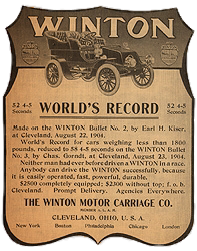ExcerptsIt's a FactIn Cleveland... After Alexander Winton produced his first horseless carriage in 1896, he was followed by many others. By 1930, 75 different nameplates had graced radiators of automobiles made in Cleveland. In 1904 the city was the nation's largest auto producer. Although Cleveland eventually lost the "Motor City" title to Detroit, Cleveland has long been the nation's second largest manufacturer of automotive components.
WantedWinton Automobile, Bicycle and diesel literature, postcards, letters, factory magazines; "The Auto Era," Ephemera, photos, miscellaneous memorabilia.
Bernie Golias |
DedicationOne of the more difficult aspects of writing a wide-ranging history such as this is doing the research. There's something exciting about tracking down elusive facts and sourcing rare photos and illustrations, to be sure, But the time spent doing it doesn't put words on paper Preceding the research is the bigger problem of finding a publisher who can be convinced that the subject near and dear to your heart is worth the investment on the premise that it will also be near and dear to the hearts of thousands or millions of other people. That's why it was such a pleasure working with Bernie Golias. Bernie's commitment to publishing a Winton book was both an incentive and an inspiration, and his perseverance in gathering Winton material enabled me to write the narrative in half the time it would have taken otherwise. There are other names mentioned in the acknowledgments, But you should be aware that if it wasn't for Bernie Golias you wouldn't be holding this book in your hands right now. Bernie should also be commended for his resiliency and his resourcefulness One of the pitfalls of doing research is discovering new facets of your story that you didn't know existed. |
Bernie never hesitated on the many occasions when I told him that I had found in his archives an answer to a question that bought up another question which would open up a whole new area of inquiry His curiosity about these new areas of investigation was just as great as mine, probably greater, and we would add new sections or new chapters to accommodate the new information we had found. The net result is a book that covers its subject as thoroughly as possible within the context of available resources. Even though we talked to a few people who personally knew Alexander Winton before he died in 1932, no part of this book can be considered oral history Nor did we rely on histories written since his death. In fact, in many cases we discovered, not surprisingly, that a lot of misinformation has been published over the years. We haven't repeated any of the widely circulated but unsubstantiated stories about Alexander Winton, his exploits, his factory and his machines unless we could find contemporaneous evidence to document them. If you should find that we've made serious errors or omitted anything crucial we would like to hear from you. Bernie has assured me that all significant new information will be induced in the second edition! Thomas F Saal February 1997 |

